Themed collection Emerging Investigators

Emerging investigators
This themed issue of Polymer Chemistry highlights the work of emerging investigators in the polymer chemistry field. Editor in Chief David Haddleton introduces the issue.

Polym. Chem., 2015,6, 5501-5502
https://doi.org/10.1039/C5PY90111A
Topology, assembly, and electronics: three pillars for designing supramolecular polymers with emergent optoelectronic behavior
Supramolecular polymers for solar energy harvesting can be created by considering carefully the relationship between topology, assembly, and photophysics.
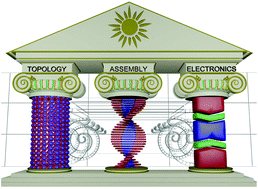
Polym. Chem., 2015,6, 5529-5539
https://doi.org/10.1039/C5PY00420A
Glyconanoparticles and their interactions with lectins
Glyconanoparticles and their interactions with lectins.
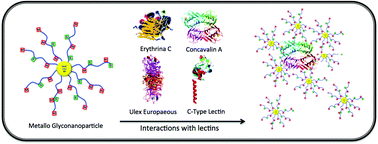
Polym. Chem., 2015,6, 5503-5514
https://doi.org/10.1039/C5PY00089K
Nanostructural heterogeneity in polymer networks and gels
Many polymer gels display network defects and crosslinking inhomogeneity. This review reflects and interrelates investigations on the characterization of such polymer-network heterogeneity and on its impact on the swelling, elasticity, and permeability of polymer gels.
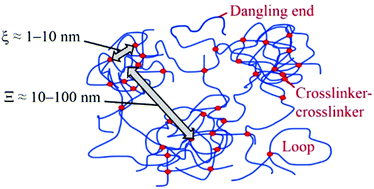
Polym. Chem., 2015,6, 5515-5528
https://doi.org/10.1039/C4PY01677G
Design of thiol- and light-sensitive degradable hydrogels using Michael-type addition reactions
Hydrogels that respond to multiple stimuli (i.e., light, reducing and aqueous microenvironment) were synthesized using thiol-Michael type reaction and degradation kinetics along with release of nanobeads was characterized.
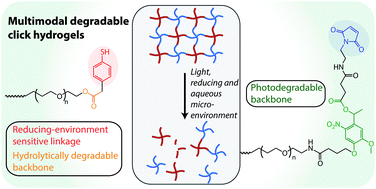
Polym. Chem., 2015,6, 5565-5574
https://doi.org/10.1039/C5PY00750J
Self-assembly of benzothiadiazole-functionalized dinuclear platinum acetylide bolaamphiphiles for bio-imaging application
Benzothiadiazole-functionalized dinuclear platinum(II) acetylide bolaamphiphiles have been demonstrated to form nanoparticles in protic solvents, serving as novel fluorescent labels for bio-imaging applications with good biocompatibility and sufficient stability.
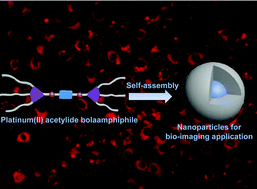
Polym. Chem., 2015,6, 5575-5579
https://doi.org/10.1039/C5PY00239G
Chemical doping enhances electronic transport in networks of hexabenzocoronenes assembled in non-aqueous electrolyte
The electronic transport properties of HBC networks in non-aqueous electrolyte are tailored using synthetic chemistry and supramolecular design principles.
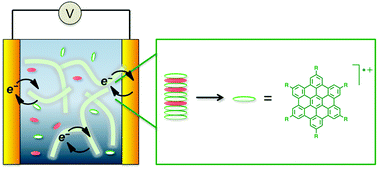
Polym. Chem., 2015,6, 5560-5564
https://doi.org/10.1039/C5PY00639B
Intra-chain radical chemistry as a route to poly(norbornene imide) single-chain nanoparticles: structural considerations and the role of adventitious oxygen
The intra-chain radical polymerization of pendant methacryloyl decorated poly(norbornene) imides is a viable route to single-chain nanoparticles, however this process is complicated by adventitious molecular oxygen.
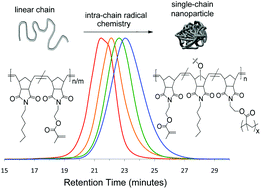
Polym. Chem., 2015,6, 5555-5559
https://doi.org/10.1039/C5PY00265F
Strong anionic polyelectrolyte microgels
We report a facile synthesis of highly uniform poly(styrene sulfonic acid) microgels, which carry a strong polyelectrolyte group at every repeating unit.
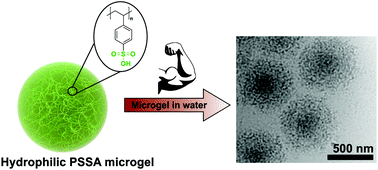
Polym. Chem., 2015,6, 5550-5554
https://doi.org/10.1039/C5PY00426H
Synthesis of 1,5-regioregular polytriazoles by efficient NMe4OH-mediated azide–alkyne click polymerization
The efficient and regioselective NMe4OH-mediated aromatic azide and alkyne click polymerization to generate 1,5-regioregular polytriazoles was successfully established.

Polym. Chem., 2015,6, 5545-5549
https://doi.org/10.1039/C5PY00186B
Well-defined supramolecular polymers based on orthogonal hydrogen-bonding and host–guest interactions
Two architecturally controlled supramolecular polymers have been fabricated via the concurrent integration of orthogonal non-covalent recognition motifs, demonstrating significant chain topological-dependent supramolecular polymerization behaviors.
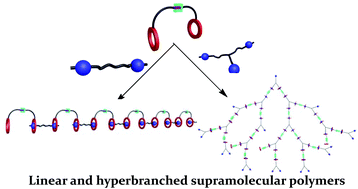
Polym. Chem., 2015,6, 5540-5544
https://doi.org/10.1039/C4PY01591F
Towards a general understanding of hydrothermal polymerization of polyimides
Hydrothermal polymerization (HTP) yields highly crystalline polyimides. A general picture of the mechanisms leading to crystallinity and morphology is provided.
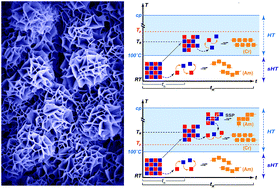
Polym. Chem., 2015,6, 5773-5781
https://doi.org/10.1039/C5PY00231A
Polymer brush functionalized SiO2 nanoparticle based Nafion nanocomposites: a novel avenue to low-humidity proton conducting membranes
Polymer brush grafted SiO2 NPs provide Nafion nanocomposite membranes with superior proton conductivities at ambient and moderately high temperatures over the entire range of relative humidity.
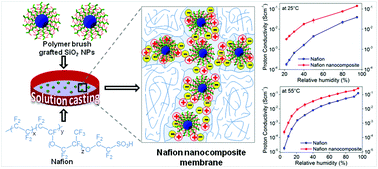
Polym. Chem., 2015,6, 5782-5789
https://doi.org/10.1039/C5PY00514K
Polymers synthesized by RAFT as versatile macrophotoinitiators
Enhancing the photodissociation efficiency of terminal functionalities in RAFT polymers makes them versatile macrophotoinitiators.
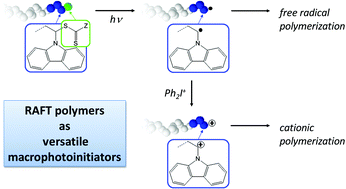
Polym. Chem., 2015,6, 5766-5772
https://doi.org/10.1039/C5PY00608B
Efficiency assessment of single unit monomer insertion reactions for monomer sequence control: kinetic simulations and experimental observations
On-line microreactor/ESI-MS experiments and kinetic simulations on single unit monomer insertions are combined to assess the efficiency of the SUMI process.
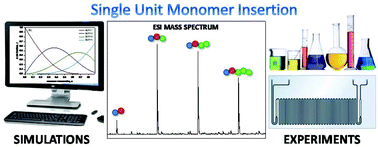
Polym. Chem., 2015,6, 5752-5765
https://doi.org/10.1039/C5PY00485C
Quantifying bacterial adhesion on antifouling polymer brushes via single-cell force spectroscopy
The adhesion forces between a single bacterial cell and different polymer brushes were measured directly with an atomic force microscope and correlated with their resistance to fouling.
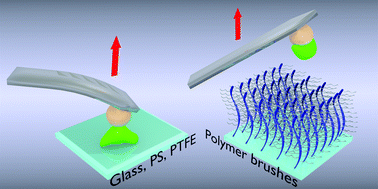
Polym. Chem., 2015,6, 5740-5751
https://doi.org/10.1039/C5PY00197H
RAFT polymerization and associated reactivity ratios of methacrylate-functionalized mixed bio-oil constituents
High separations costs reduce the practicality of polymers sourced from renewable bio-oils, motivating economical multicomponent bio-oil polymerizations. Thus, this paper investigates polymerization behavior of model bio-oil components and their mixtures.
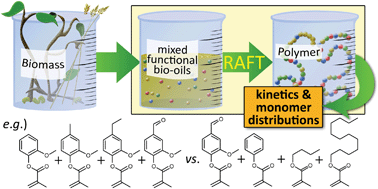
Polym. Chem., 2015,6, 5728-5739
https://doi.org/10.1039/C5PY00291E
The synthesis and aqueous solution properties of sulfobutylbetaine (co)polymers: comparison of synthetic routes and tuneable upper critical solution temperatures
With an additional methyl group in the ion bridge, sulfobutylbetaine (co)polymers show significantly higher UCSTs than their more common sulfopropylbetaine counterparts making them a promising class of smart materials.
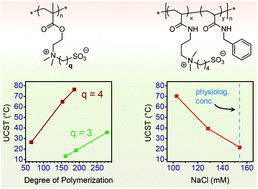
Polym. Chem., 2015,6, 5705-5718
https://doi.org/10.1039/C5PY00160A
Simulation of radical polymerization of methyl methacrylate at room temperature using a tertiary amine/BPO initiating system
A model was developed for the polymerization of methyl methacrylate at room temperature. The model used both free volume and empirical models for propagation, termination and several side reactions.

Polym. Chem., 2015,6, 5719-5727
https://doi.org/10.1039/C5PY00229J
Dendronized hyperbranched polymers containing isolation chromophores: design, synthesis and further enhancement of the comprehensive NLO performance
New dendronized hyperbranched polymers (DHPs) constructed by dendronized monomers, exhibit good comprehensive NLO performance, especially for thermostability.
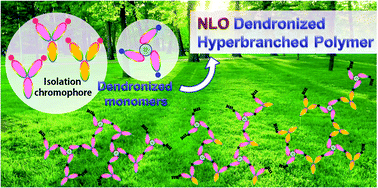
Polym. Chem., 2015,6, 5580-5589
https://doi.org/10.1039/C5PY00155B
Multifunctional and spatially controlled bioconjugation to melt coextruded nanofibers
A simple photochemical modification scheme is utilized to fabricate multifunctional and patterned coextruded fibers.
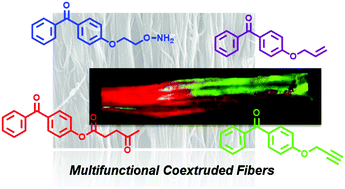
Polym. Chem., 2015,6, 5683-5692
https://doi.org/10.1039/C5PY00282F
On the structure–control relationship of amide-functionalized SG1-based alkoxyamines for nitroxide-mediated polymerization and conjugation
Investigation on the reactivity and the controlling ability of a series of amide-functionalized alkoxyamines based on the SG1 nitroxide is reported.

Polym. Chem., 2015,6, 5693-5704
https://doi.org/10.1039/C5PY00283D
Film-type chemosensors based on boron diiminate polymers having oxidation-induced emission properties
We present here the film-type chemosensors based on stimuli-responsive emissive polymers composed of boron diiminate. Hydrogen peroxide can be monitored by the emission enhancement.
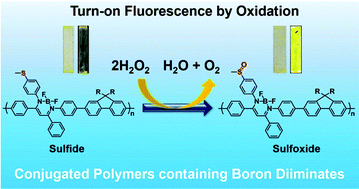
Polym. Chem., 2015,6, 5590-5595
https://doi.org/10.1039/C5PY00055F
Frequency control of crossover reactions in concurrent cationic vinyl-addition and ring-opening copolymerization of vinyl ethers and oxiranes: specific roles of weak Lewis bases and solvent polarity
Weak Lewis bases and solvent polarity affected the frequency of the crossover reactions in the concurrent cationic vinyl-addition and ring-opening copolymerization of vinyl ethers and oxiranes.
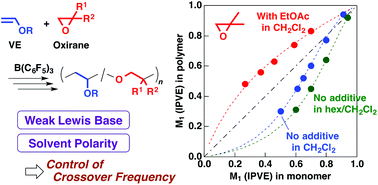
Polym. Chem., 2015,6, 5675-5682
https://doi.org/10.1039/C5PY00152H
A convenient synthesis strategy for microphase-separating functional copolymers: the cyclohydrocarbosilane tool box
Functional polyhydrocarbosilane-based homo and diblock copolymers are prepared by combination of anionic ring-opening polymerization and postmodification with functional vinyl compounds.
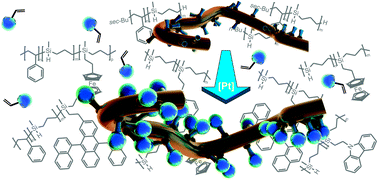
Polym. Chem., 2015,6, 5653-5662
https://doi.org/10.1039/C5PY00065C
Fluorinated microgel star polymers as fluorous nanocapsules for the encapsulation and release of perfluorinated compounds
Fluorinated microgel star polymers work as fluorous nanocapsules to efficiently capture and thermo-responsively release perfluorinated guest compounds.
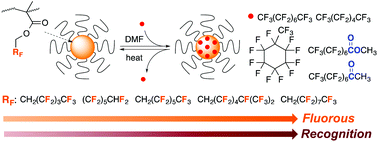
Polym. Chem., 2015,6, 5663-5674
https://doi.org/10.1039/C5PY00113G
Synthesis of bottlebrush polymers via transfer-to and grafting-through approaches using a RAFT chain transfer agent with a ROMP-active Z-group
A novel dithiocarbamate chain transfer agent for reversible addition–fragmentation chain transfer polymerization with a directly polymerizable Z-group was synthesized and used to make bottlebrush polymers via multiple strategies.
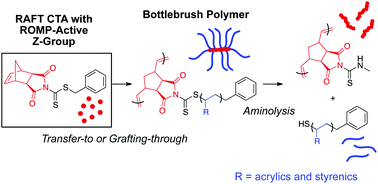
Polym. Chem., 2015,6, 5643-5652
https://doi.org/10.1039/C4PY01567C
Amphiphilic polyether-based block copolymers as crosslinkable ligands for Au-nanoparticles
We report on the synthesis of thiol-terminated, polyether-based block copolymers featuring a crosslinkable block and their use as ligands for Au-nanoparticles in organic solvents.
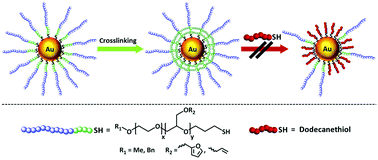
Polym. Chem., 2015,6, 5633-5642
https://doi.org/10.1039/C4PY01434K
Functional, sub-100 nm polymer nanoparticles via thiol–ene miniemulsion photopolymerization
Thiol–ene photopolymerization in miniemulsion under non-stoichiometric conditions offers a facile route to functionalized polymer nanoparticles.
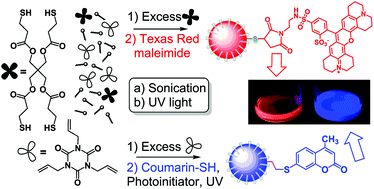
Polym. Chem., 2015,6, 5625-5632
https://doi.org/10.1039/C4PY01449A
Organo-photocatalysts for photoinduced electron transfer-reversible addition–fragmentation chain transfer (PET-RAFT) polymerization
In this work, we demonstrate the use of organophotoredox catalysts under visible light to perform photoinduced electron transfer-reversible addition fragmentation chain transfer (PET-RAFT) for the polymerization of methacrylate monomers.
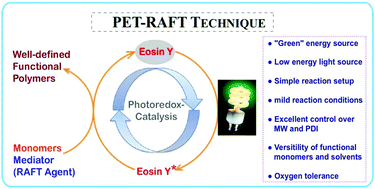
Polym. Chem., 2015,6, 5615-5624
https://doi.org/10.1039/C4PY01317D
Polymer-protein conjugation via a ‘grafting to’ approach – a comparative study of the performance of protein-reactive RAFT chain transfer agents
The performances of various protein-reactive RAFT CTAs to afford polymer-protein conjugation via a grafting-to approach were compared.
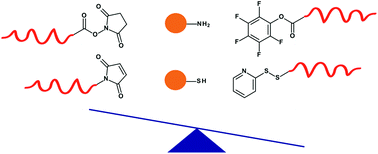
Polym. Chem., 2015,6, 5602-5614
https://doi.org/10.1039/C4PY01224K
Chemical encoding of amphiphilic copolymers for a dual controlled release from their assemblies
Amphiphilic random copolymers are designed to bear a corrosion inhibitor as cleavable side group, which can be released upon activation by chemical reduction.

Polym. Chem., 2015,6, 5596-5601
https://doi.org/10.1039/C4PY01159G
Correction: Polymer–protein conjugation via a ‘grafting to’ approach – a comparative study of the performance of protein-reactive RAFT chain transfer agents
Polym. Chem., 2015,6, 5798-5798
https://doi.org/10.1039/C5PY90115D